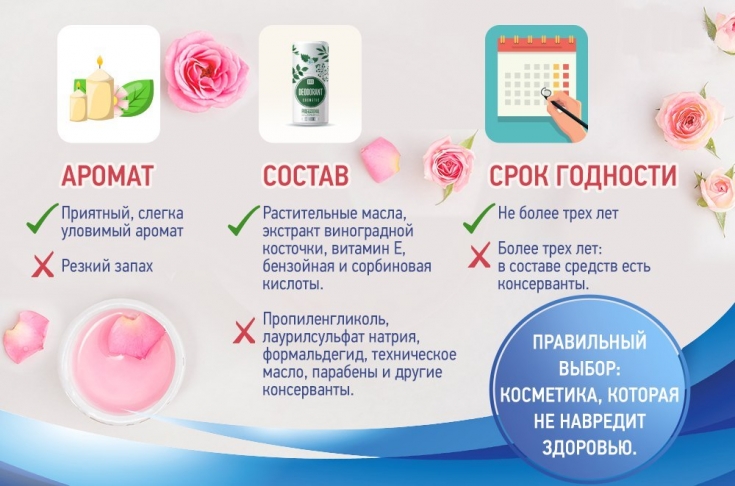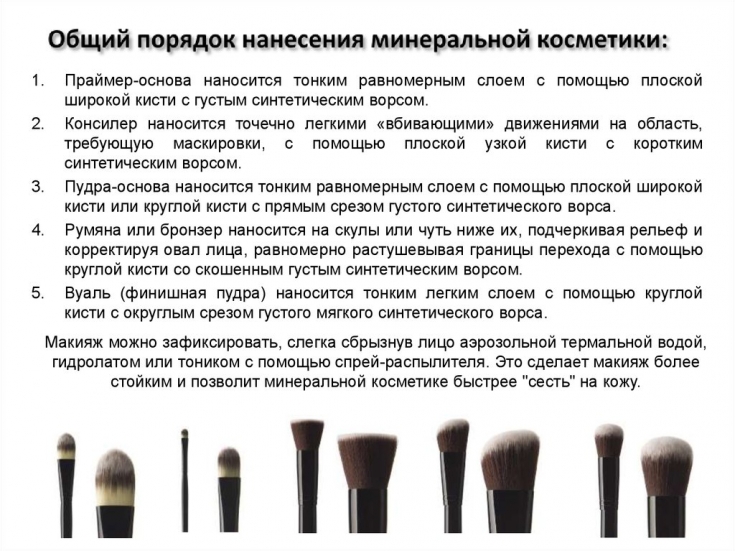The fashion for healthy lifestyle and propaganda of conscious choice literally make you take a close look at the things we are used to. What do we eat? How do we clean our teeth? And, yes, what do we put on makeup in the morning? It turns out that habitual lipsticks, mascara and foundation can contain many dangerous ingredients. So whether it really, and how great harm cosmetics we will understand in this article.
- Top 7 Hazardous Substances in Cosmetics
- How to minimize the harm of cosmetics
- Are there harmless cosmetics
- Mineral cosmetics
- Organic cosmetics
Top 7 dangerous substances in cosmetics
What what do we pay attention to when choosing "decoratives"? We expect from the product saturation and deepness of shades, pleasant texture, durability, fulfillment of the promises declared by the manufacturer (matting, masking, radiance, etc.). To ensure all this, and also increase the shelf life, do not do without preservatives, synthetic additives, silicones. Some of them are really dangerous to health, as proven by studies and clinical trials. Below is a list of the most common hazardous ingredients:
-
Phthalates. Added to give a "wet" finish. films in glitters, lipsticks, etc. They inhibit reproductive function, affect the hormonal background, and can contribute to the development of insulin resistance.
-
Ceteareth. An emulsifier that helps prevent segregation of the product. Can be added to foundations, primers, liquid lipsticks and shadows. Increases skin permeability, provokes irritation.
-
Formaldehyde. Often found in nail polishes. It is very toxic, which is why it is prohibited for use in cosmetics in its pure form, but manufacturers have replaced it with formaldehyde releases. These substances can release formaldehyde under certain conditions (e.g. improper storage or transport).
-
Methylisothiazolinone. Used as a preservative, can provoke dermatitis, breaks the integrity of cell membranes, increasing skin sensitivity to harmful substances.
-
Acetamide. Locks in moisture and prevents cream textures from drying out. It has mutagenic properties, it belongs to carcinogens.
-
Alcohol. Natural alcohol is not harmful to health, but synthetic simple alcohols, which are used as preservatives, dry out the skin, violate its protective barrier, and contribute to better penetration of harmful components.
-
Hydroquinone. Used as an optical brightener in brightening products (concealer, corrector). Reduces the production of melanin, thereby reducing the skin's protection against UVA and UVB rays.
Unfortunately, it is impossible to achieve a complete ban on the use of dangerous and potentially dangerous components. In most countries, the production of cosmetics is regulated very loosely, and labeling requirements do not oblige to write the entire list of ingredients used in the production. Yes and finding a replacement for the same preservatives is not so easy, and losing millions due to spoiled cosmetics will not agree to not a single concern. It remains only to hope for your prudence and carefully read the ingredients.

Read also: Which cosmetic products are best not to combine with each other
How to minimize the harm of cosmetics
In theory, each ingredient can be potentially dangerous, but it is the dosage and duration of interaction. If you are afraid of every possible harmful substance, it will turn out that it is better to abandon cosmetics altogether. In fact, everything is not so scary, especially if you approach the choice of products correctly. What you need to consider when buying to reduce the harm of cosmetics.
-
Choose products with a minimum expiration date. The longer you can store the product, the more preservatives it contains, among which the maximum amount of harmful ingredients.
-
Do not buy cosmetics that are stored inappropriately (outdoors, under lamps, without protective packaging).
-
Favor dry textures. If you don't care if you use dry or cream blush, choose dry ones, they will be shorter.
-
Purchase products without strong fragrance. This way you can reduce the risk of negative effects of chemical fragrances.
Make it a rule to wash off makeup not at at night, but when you come home from work. By reducing the interaction time, we reduce the possible harm of cosmetics. To to the same for the whole day on the face forms such a "pie" from oxidized decor, dust and sebum, that your skin will thank you for timely cleansing.
And more: don do not use expired cosmetics. No. Any product will have a preservative added and steam — three stabilizing elements (yes, even in & nbsp; dry shadows, otherwise they & nbsp; cannot be compressed). How these ingredients will behave after months/years is difficult to predict.

Read also: How to look younger than your years: the secrets of makeup artists
Are there any harmless cosmetics
Is it possible to reduce the harm of cosmetics by choosing safe products? Yes, and the attention of buyers is increasingly attracted by organic and mineral products, which are positioned as natural and hypoallergenic. Let's take a closer look at each category.
Mineral cosmetics
To be eligible to be called mineral, cosmetics must consist exclusively of minerals of natural origin. This limits the ability of manufacturers, since lip gloss or mineral cream cannot be made. But powder, shadows, dry concealer, blush — quite. If the product contains a liquid or plastic base, then these cosmetics are mineralized, but not mineralized. Mineral makeup brands: Alima Pure, Lumiere Cosmetics.

Organic cosmetics
These products are labeled "ECO" or "BIO". The composition must contain at least 95% organic components. Organic — these are components of plant origin, the raw materials for which are grown in environmentally friendly conditions, processed without the use of chemicals, and the entire production process does not harm the environment. Eco-brands, for example, are Dr. Hauschka, Korres, Nude.
Which same cosmetics is better? Real, certified organic cosmetics won't harm your skin, it's true. But this does mean that it will not cause allergies and will produce inflammation. So, natural oils are very comedogenic, and extracts from plants can provoke allergies (to be fair, anything can provoke it).
Mineral cosmetics are safer due to a more concise composition and the absence of greasy bases, but its range is limited. However, in each of segments, you can find suitable products, thus collecting your safe cosmetic bag.
Read also: Hair Extensions: What Masters Tell
You may be interested in: How to visually enlarge lips with makeup.






Add a comment